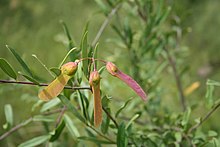Polygalaceae
| Polygalaceae | |
|---|---|

| |
| Securidaca longipedunculata | |
| Scientific classification | |
| Kingdom: | Plantae |
| Clade: | Tracheophytes |
| Clade: | Angiosperms |
| Clade: | Eudicots |
| Clade: | Rosids |
| Order: | Fabales |
| Family: | Polygalaceae Hoffmanns. & Link[1] |
| Type genus | |
| Polygala | |
| Tribes | |

| |
| Distribution of the Polygalaceae. | |
| Synonyms | |
| |
The Polygalaceae or the milkwort family are made up of flowering plants in the order Fabales. They have a near-cosmopolitan range, with about 21 genera and ca. 900 known species[2] of herbs, shrubs and trees. Over half of the species are in one genus, Polygala, the milkworts.
Under the Cronquist classification system, Polygalaceae were treated in a separate order of their own, Polygalales. Currently, according to the Angiosperm Phylogeny Group, the family belongs in Fabales.
Tribes and genera
The Polygalaceae comprise the following genera,[3] with tribes based on various sources.[4][5][6][7][8][9]
- Carpolobieae Eriksen
- Atroxima Stapf
- Carpolobia G. Don
- Moutabeae Chodat
- Barnhartia Gleason
- Diclidanthera Mart.
- Eriandra P. Royen & Steenis
- Moutabea Aubl.
- Polygaleae Chodat
- Acanthocladus Klotzsch ex Hassk.
- Ancylotropis B. Eriksen
- Asemeia Raf.
- Badiera DC.
- Bredemeyera Willd.
- Caamembeca J.F.B. Pastore
- Comesperma Labill.
- Epirixanthes Blume
- Gymnospora (Chodat) J.F.B. Pastore
- Hebecarpa (Chodat) J.R. Abbott
- Heterosamara Kuntze
- Hualania Phil.
- Monnina Ruiz & Pav.
- Muraltia DC.
- Phlebotaenia Griseb.
- Polygala L.
- Polygaloides Haller
- Rhinotropis (S.F. Blake) J.R. Abbott
- Salomonia Lour.
- Securidaca L.
- Xanthophylleae Chodat
- Xanthophyllum Roxb.
- Other genera
- Monrosia Grondona
- Trigoniastrum Miq.
Fossils
- †Deviacer Manchester
- †Paleosecuridaca Pigg, Kathleen B., M.L. DeVore & M.F. Wojc. 2008
Systematics
Modern molecular phylogenetics suggest the following relationships:[9][10][11][12][13][14]
| ||||||||||||||||||||||||||||||||||||||||||||||||||||||||||||||||||||||||||||||||||||||||
References
- ^ Angiosperm Phylogeny Group (2009). "An update of the Angiosperm Phylogeny Group classification for the orders and families of flowering plants: APG III" (PDF). Botanical Journal of the Linnean Society. 161 (2): 105–121. doi:10.1111/j.1095-8339.2009.00996.x. Retrieved 2013-07-06.
- ^ Christenhusz, M. J. M.; Byng, J. W. (2016). "The number of known plants species in the world and its annual increase". Phytotaxa. 261 (3): 201–217. doi:10.11646/phytotaxa.261.3.1.
{{cite journal}}: Unknown parameter|lastauthoramp=ignored (|name-list-style=suggested) (help) - ^ "Polygalaceae Hoffmanns. & Link". Plants of the World Online. Royal Botanic Gardens, Kew. Retrieved 2020-04-14.
- ^ Abbott JR. (2011). "Notes on the disintegration of Polygala (Polygalaceae), with four new genera for the flora of North America". Journal of the Botanical Research Institute of Texas. 5 (1): 125–137. JSTOR 41972495.
- ^ Pastore JFB. (2012). "Caamembeca: Generic status and new name for Polygala subgenus Ligustrina (Polygalaceae)". Kew Bull. 67 (3): 435–442. doi:10.1007/s12225-012-9360-x.
- ^ Pastore JF, Rodrigues de Moraes PL (2013). "Generic status and lectotypifications for Gymnospora (Polygalaceae)". Novon. 22 (3): 304–306. doi:10.3417/2010113.
- ^ Abbott JR, Pastore JF (2015). "Preliminary synopsis of the genus Hebecarpa (Polygalaceae)". Kew Bull. 70 (3): 39. doi:10.1007/s12225-015-9589-2.
- ^ Freire-Fierro A. (2015). Systematics of Monnina (Polygalaceae) (Ph.D.). Drexel University. Archived from the original on 2017-03-19. Retrieved 2017-03-19.
- ^ a b Pastore JF, Abbott JR, Neubig KM, Whitten WM, Mascarenhas RB, Almeida Mota MC, van den Berg C (2017). "A molecular phylogeny and taxonomic notes in Caamembeca (Polygalaceae)". Syst Bot. 42 (1): 54–62. doi:10.1600/036364417X694935.
- ^ Persson C. (2001). "Phylogenetic relationships in Polygalaceae based on plastid DNA sequences from the trnL–F region". Taxon. 50 (3 (Golden Jubilee Part 5)): 763–779. doi:10.2307/1223706. JSTOR 1223706.
- ^ Forest F, Chase MW, Persson C, Crane PR, Hawkins JA (2007). "The role of biotic and abiotic factors in evolution of ant dispersal in the milkwort family (Polygalaceae)". Evolution. 61 (7): 1675–1694. doi:10.1111/j.1558-5646.2007.00138.x. PMID 17598748.
- ^ Bello MA, Bruneau A, Forest F, Hawkins JA (2009). "Elusive relationships within order Fabales: Phylogenetic analyses using matK and rbcL sequence data". Syst Bot. 34 (1): 102–114. doi:10.1600/036364409787602348.
- ^ Abbott JR. (2009). Phylogeny of the Polygalaceae and a revision of Badiera (PDF) (Ph.D.). University of Florida.
- ^ Mennes CB, Moerland MS, Rath M, Smets EF, Merckx VS (2015). "Evolution of mycoheterotrophy in Polygalaceae: The case of Epirixanthes". Am J Bot. 102 (4): 598–608. doi:10.3732/ajb.1400549. PMID 25878092.
External links
![]() Media related to Polygalaceae at Wikimedia Commons
Media related to Polygalaceae at Wikimedia Commons
